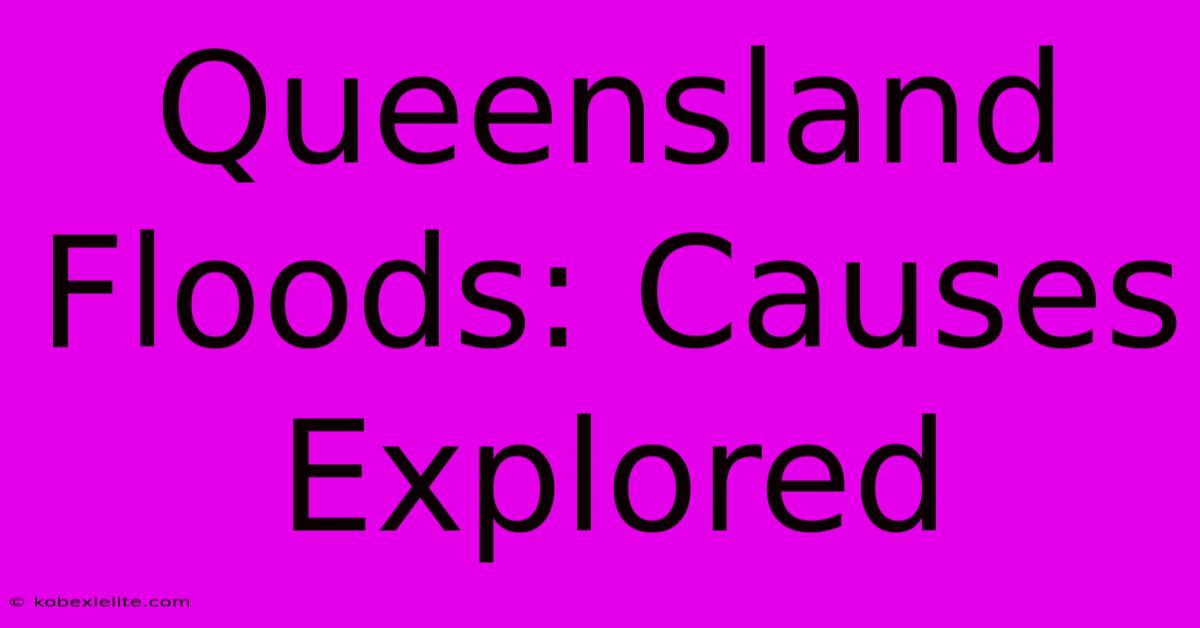Queensland Floods: Causes Explored

Discover more detailed and exciting information on our website. Click the link below to start your adventure: Visit Best Website mr.cleine.com. Don't miss out!
Table of Contents
Queensland Floods: Causes Explored
Queensland, Australia, is no stranger to devastating floods. The state's geography, coupled with its weather patterns, creates a perfect storm (pun intended!) for significant rainfall events that often lead to widespread flooding. Understanding the causes of these floods is crucial for developing effective mitigation strategies and building community resilience. This article delves into the key factors contributing to Queensland's frequent flood disasters.
The Role of Geography in Queensland Floods
Queensland's unique geography plays a significant role in its susceptibility to flooding. Several geographical factors contribute to the problem:
- Coastal Location: Queensland's extensive coastline exposes it to tropical cyclones and intense rainfall associated with monsoonal troughs. These weather systems can dump enormous quantities of rain in short periods, overwhelming drainage systems and leading to rapid river rises.
- Mountain Ranges: The Great Dividing Range runs along the eastern coast of Queensland. This range acts as a natural barrier, forcing moisture-laden air to rise, cool, and condense, leading to increased rainfall on the eastern slopes. This concentrated rainfall can quickly saturate the soil, increasing the risk of landslides and flash flooding.
- River Systems: Queensland's vast river systems, including the Fitzroy, Burdekin, and Brisbane Rivers, are prone to flooding. These rivers often have large catchments, meaning that rainfall from a wide area drains into a single river channel. Heavy rainfall across the catchment can lead to rapid and significant river level increases, causing widespread inundation.
- Flat Terrain: Large stretches of flat terrain in Queensland's inland areas mean that water spreads easily, leading to extensive flooding. This flat topography also hinders the rapid drainage of water, exacerbating flood impacts.
The Impact of La Niña
The Influence of Weather Patterns: La Niña and the Monsoon Trough
Beyond geography, weather patterns are key drivers of Queensland's flooding. La Niña, a climate pattern characterized by unusually cool temperatures in the central and eastern tropical Pacific Ocean, is often associated with increased rainfall in eastern Australia, including Queensland. La Niña events tend to strengthen the monsoon trough, leading to prolonged periods of heavy rainfall.
This increased rainfall can saturate the ground, leading to:
- Increased runoff: When the ground is already saturated, less water infiltrates the soil, resulting in increased surface runoff that flows into rivers and streams, rapidly increasing water levels.
- Riverine flooding: The cumulative effect of increased runoff from across a large catchment can result in major riverine flooding, impacting towns and cities along the riverbanks.
- Flash flooding: In areas with steep slopes and intense rainfall, flash floods can occur with little or no warning, posing significant risks to life and property.
Human Impact: Urban Development and Deforestation
While natural factors are the primary drivers of Queensland floods, human activities exacerbate the problem:
- Urban Development: Increased urbanization and infrastructure development often lead to reduced drainage capacity and increased surface runoff. Impervious surfaces like concrete and asphalt prevent water from soaking into the ground, leading to more rapid and intense flooding.
- Deforestation: The removal of vegetation reduces the ability of the land to absorb rainfall, increasing runoff and exacerbating flood risks. Trees also help to stabilize soil, so deforestation can increase the risk of landslides.
Conclusion: A Complex Interaction
The causes of Queensland floods are complex and multifaceted, resulting from an interaction of geographical features, weather patterns, and human activities. Understanding these interacting factors is crucial for developing effective strategies to reduce flood risk, including improved land-use planning, enhanced early warning systems, and infrastructure upgrades to withstand extreme rainfall events. By acknowledging the complexities of this issue, Queensland can continue working toward a more resilient and flood-prepared future.
Keywords:
Queensland floods, causes of Queensland floods, La Niña, monsoon trough, geography of Queensland, flood mitigation, urban development, deforestation, river systems, climate change, flood risk, natural disasters, Australian floods, extreme weather, rainfall patterns, flood preparedness, disaster management.

Thank you for visiting our website wich cover about Queensland Floods: Causes Explored. We hope the information provided has been useful to you. Feel free to contact us if you have any questions or need further assistance. See you next time and dont miss to bookmark.
Featured Posts
-
Bayerns Tel Snubs Spurs
Feb 02, 2025
-
France Wales Six Nations Match Recap
Feb 02, 2025
-
Predicting Benavidez Vs Morrell Jr Fight Odds
Feb 02, 2025
-
Review Companion What Worked What Didnt
Feb 02, 2025
-
Ajax Keep Henderson Amidst Monaco Interest
Feb 02, 2025
